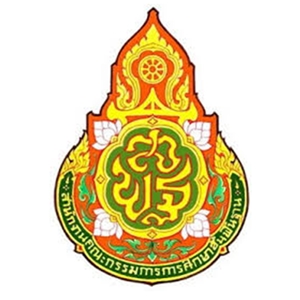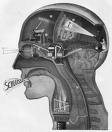บทคัดย่อ
การวิจัยและพัฒนารูปแบบการจัดการเรียนรู้วิทยาศาสตร์เพื่อส่งเสริมทักษะการคิดอย่างมีวิจารณญาณและ จิตวิทยาศาสตร์ของนักเรียนชั้นมัธยมศึกษาปีที่ 3 มีวัตถุประสงค์ 1) เพื่อศึกษาข้อมูลพื้นฐานในการพัฒนารูปแบบ 2) เพื่อพัฒนารูปแบบและหาประสิทธิภาพ 3) เพื่อทดลองใช้รูปแบบ 4) เพื่อประเมินประสิทธิผลของรูปแบบ โดยเปรียบเทียบก่อนเรียนและหลังเรียน ด้านทักษะการคิดอย่างมีวิจารณญาณ ด้านจิตวิทยาศาสตร์ ด้านผลสัมฤทธิ์ทางการเรียน และศึกษาความพึงพอใจต่อการเรียนรู้ตามแนวรูปแบบ กลุ่มตัวอย่าง คือ นักเรียนชั้นมัธยมศึกษาปีที่ 3/2 ภาคเรียนที่ 2 ปีการศึกษา 2557 จำนวน 38 คน โรงเรียนเทศบาล 3 วัดไชนาวาส เทศบาลเมืองสุพรรณบุรี อำเภอเมืองสุพรรณบุรี จังหวัดสุพรรณบุรี เครื่องมือที่ใช้ประกอบด้วย รูปแบบการจัดการเรียนรู้วิทยาศาสตร์เพื่อส่งเสริมทักษะ การคิดอย่างมีวิจารณญาณและจิตวิทยาศาสตร์ คู่มือการใช้รูปแบบ แผนการจัดการเรียนรู้ แบบประเมินทักษะการคิดอย่างมีวิจารณญาณ แบบประเมินจิตวิทยาศาสตร์ แบบประเมินผลสัมฤทธิ์ทางการเรียน และแบบประเมิน ความพึงพอใจ วิเคราะห์ข้อมูลโดยการหาค่าเฉลี่ย ค่าส่วนเบี่ยงเบนมาตรฐาน ค่าสถิติ t-test dependent และการวิเคราะห์เนื้อหา ผลการวิจัย พบว่า
1. ในการจัดการเรียนรู้วิชาวิทยาศาสตร์ นักเรียนควรได้รับการส่งเสริมทักษะการคิดอย่างมีวิจารณญาณ และพฤติกรรม/ค่านิยมที่ดีงามด้านจิตวิทยาศาสตร์
2. รูปแบบการจัดการเรียนรู้วิทยาศาสตร์เพื่อส่งเสริมทักษะการคิดอย่างมีวิจารณญาณและจิตวิทยาศาสตร์ของนักเรียนชั้นมัธยมศึกษาปีที่ 3 มี 4 องค์ประกอบ (1) หลักการและวัตถุประสงค์ หลักการ คือ มนุษย์เป็นผู้มีเหตุผล และมีความพร้อมที่จะพัฒนาตนเองในระดับที่แตกต่างกันด้วยกระบวนการคิดอย่างมีวิจารณญาณ ร่วมมือกันใน การเรียนรู้ และมีการเสริมแรงที่เหมาะสมเพื่อการเรียนรู้อย่างมีความหมาย มีวัตถุประสงค์ ส่งเสริมทักษะการคิดอย่าง มีวิจารณญาณ จิตวิทาศาสตร์ ผลสัมฤทธิ์ทางการเรียน และศึกษาความพึงพอใจ (2) กระบวนการของรูปแบบที่พัฒนา ชื่อ มีแมค (MEMC Model) ประกอบด้วย ขั้น 1 สร้างศรัทธา (M: Make believe) ได้แก่ 1) กายจิตสมาธิ 2) มิติสัมพันธ์ ขั้น 2 เสริมกระบวนการ (E: Extra processes) ได้แก่ 1) จุดประสงค์/มโนทัศน์กว้าง 2) การเรียนรู้สาระใหม่ 3) กิจกรรม CTP ขั้น 3 ผสานค่านิยม (M: Merge values) ขั้น 4 สะสม/เสริมแรง (C:Collector/reinforcement) (3) การวัดผลประเมินผล 4 ด้าน คือ ทักษะการคิดอย่างมีวิจารณญาณ จิตวิทยาศาสตร์ ผลสัมฤทธิ์ทางการเรียน และความพึงพอใจของนักเรียน และ (4) เงื่อนไขการนำรูปแบบไปใช้ นักเรียนควรมีความพร้อมทางกาย จิตใจ อารมณ์ ปฏิสัมพันธ์ที่ดี และเห็นความสำคัญในสถานการณ์หรือบทเรียน โดยพบว่า รูปแบบการจัดการเรียนรู้วิทยาศาสตร์มีประสิทธิภาพ เท่ากับ 81.95/82.96 ซึ่งสูงกว่าเกณฑ์ 80/80 ที่กำหนดไว้
3. ทดลองจัดการเรียนรู้ตามแนวรูปแบบ MEMC Model กับนักเรียนชั้นมัธยมศึกษาปีที่ 3 วิชาวิทยาศาสตร์ หน่วยการเรียนรู้ที่ 1 แรง การเคลื่อนที่และพลังงาน
4. ประสิทธิผลของรูปแบบ MEMC Model พบว่า นักเรียนมีทักษะการคิดอย่างมีวิจารณญาณหลังเรียน ภาพรวมอยู่ในระดับสูง และสูงกว่าก่อนเรียนซึ่งอยู่ในระดับควรปรับปรุง อย่างมีนัยสำคัญทางสถิติที่ระดับ .05 ด้านจิตวิทยาศาสตร์ของนักเรียนหลังเรียนภาพรวมอยู่ในระดับมากที่สุด และมากกว่าก่อนเรียนซึ่งอยู่ในระดับปานกลาง ด้านผลสัมฤทธิ์ทางการเรียนมีคะแนนหลังเรียนระดับคุณภาพสูง และสูงกว่าก่อนเรียนซึ่งอยู่ในระดับพอใช้ อย่างมีนัยสำคัญทางสถิติที่ระดับ .05 และความพึงพอใจของนักเรียนต่อการเรียนรู้ตามแนวรูปแบบ ภาพรวมอยู่ในระดับ มากที่สุด
Pisamai Hongtong: The Development of a Model for Managing the Learning of Science in Support of
the Critical Thinking Skills and the Scientific Mind of Mattayom 3 Students
Abstract
Researching and developing a model for managing the learning of science in support of the critical thinking skills and the scientific mind of Mattayom 3 students has the following objectives: 1. To study background information in order to develop a model, 2. To develop a model and search for its effectiveness, 3. To experiment the model, and 4. To evaluate the effectiveness of the model through pre-post learning by comparing the critical thinking skills, the scientific mind, the learning achievement, and the satisfaction in the learning as per the model. The sample group of this study was 38 Mattayom 3/2 students studying the second semester, academic year of B.E. 2557 at Wat Chinawas Municipality School 3, Muang Suphanburi, Suphanburi. The instruments used in this research con-sisted of the model for managing the learning of science in support of the critical thinking skills and the scientific mind, the manual on how to use the model for managing the learning, the critical thinking skills evaluation form, the scien-tific mind evaluation form, the learning achievement evaluation form, and the satisfaction evaluation form. The data was analysed using average, standard deviation, and t-test dependent. The analysis of the research results found that:
1. In managing the learning of science, the students should be encouraged to gain the critical thinking skills and the behaviour/good value for scientific mind;
2. The model for managing the learning of science in support of the critical thinking skills and the scientific mind of Mattayom 3 students had 4 elements as follows: 1. Principle and Objective: Principle: humans are with reasons and prepared to improve themselves to different levels based on their critical thinking processes, collaboration in learning, and appropriate reinforcement for meaningful learning, Objective: to support the critical thinking skills, the scientific mind, the learning achievement; and to study satisfaction, 2. Processes of the developed model: the MEMC Model consists of Step 1 M: Make believe, which includes 1) mind concentration, 2) spatial temporal; Step 2 E: Extra processes, which includes 1) objectives/broad visions, 2) learning new information, 3) CTP activities; Step 3 M: Merge values; and Step 4 C:Collector/Reinforcement, 5. Assessment and Evaluation 4 issues: the critical thinking skills, the scientific mind, the learning achievement, and the satisfaction. 4. Conditions of using the model: the students should be prepared in terms of their readiness in maturation, mentality, and emotional intelligence; have good interactions; and see the importance of situations or lessons: it was found that the model for managing the learning of science worked effectively at 81.95/82.96, which was higher than the set criteria of 80/80.
3. Experimented managing the learning as per the MEMC Model with the Mattayom 3 students studying the Science Subject, Learning Unit 1 on Force, Movement, and Energy.
4. Effects of the MEMC Model found that the students had the critical thinking skills after the learning. In general, it was at a high level in which it was higher than the period before learning, which was at a needing improvement level. This resulted in a statistically significant level of .05. As for the scientific mind of the students after the learning, in general, it was at highest level in which it was higher than the period before learning, which was at the middle level. In terms of the learning achievement, the scores after the learning were at a high quality level in which it was higher before the period before learning, which was at a fair level. This resulted in a statistically significant level of .05. The satisfaction of the students in their learning as per the model was at the highest level.



 ค้นหาทุกอย่างในเว็บครูบ้านนอก :
ค้นหาทุกอย่างในเว็บครูบ้านนอก :































